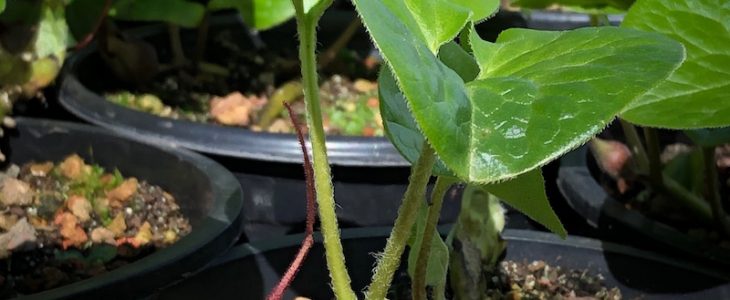
by Nicole Witch-Hazel
One of the delightful plants we propagate at Oaktown Native Plant Nursery is wild ginger Asarum caudatum. Wild ginger is an attractive evergreen ground-cover for under redwoods and moist, shady places. It also grows well in large sized deep containers, kept damp but with good drainage. Asarum loves a loamy sandy soil mix. It’s easily cultivated, though slow to grow following transplant.
If you’re out in the wild and you find wild ginger, you’re probably in the understory of an old growth forest: filtered light, deep shade, thick conifer duff, and in arm’s-reach or eye-shot of a riparian way or seepy corridor. Asarum thrives in evergreen forests where soils are high in organic matter and acidity, among a diversity of plant species connected and relating through a complex of mycorrhizal fungi.
In California Asarum caudatum grows mostly in the mountains of the coastal range, from Santa Cruz to Del Norte county. Its range pushes inland through the Trinity/Marble/Siskiyou maze of mountain ranges, to about the northern most tip of the Sierra. There its northern range ends, and two other ginger species (A. hartwegii, A. lemmonii) begin and follow the Sierra south to Tulare county.
In the field I have seen wild ginger in the redwood forest, set dead in the middle of a thin crick winding its way from ravine to ravine. In larger seasonal waterways, I’ve seen it occupy the banks along the high water mark left by winter rainfall amid a mix of Douglas fir, white oak, and big-leaf maple. I’ve seen it even higher up the water table, a ground cover at the feet of old-growth redwoods intermingled with Trillium, Western bleeding heart, and violet, but still I was in ear-shot of a river bend. The ‘tell’ between the wild ginger leaf and similar looking violets, is the spicy taste and smell of the leaf. Its shy, burgundy wine colored flower will be hidden under the kidney shaped leaves.
Wild ginger IS NOT the same plant as the ginger sold commercially in supermarkets and celebrated as a beneficial must-have in the kitchen. THAT ginger, is Zingiber officinale, a cultivated plant from maritime Southeast Asia. Zingiber and Asarum are not even in the same family. Asarum is in the Aristolochiaceae: the same family as Dutchman’s pipe vine (Aristolochia californica!).
OUR wild ginger, while having similar medicinal uses and effects as Zingiber, is definitely different from culinary ginger in a multitude of ways. In addition to them being in different families, they have different growing habits, different root structures, different potencies, different preparations, and very different environmental needs.
Medicinally, wild ginger is used as a diaphoretic (i.e. it makes you sweat). Wild ginger can help shake loose a cold, congestion, or a crampy boggy period (by warming and perspiring the repro). It is a wonder for sweating-out and breaking a fever (especially as a hot tea). It can help stimulate secretions in the lungs and sinuses, when either is dry and weighed down with mucus (perhaps helpful in mild to moderate cases of the current flu). Asarum is also a useful anti-microbial.
On the whole Asarum is far less potent than Zingiber, and its uses are not as far reaching. Zingiber is generally superior, and safer, but Asarum is local and easier to cultivate. Asarum contains Aristolochic acid, which is recognized as a carcinogen. The acid has a complicated scientific history of treating cancer, AND causing cancer (like radiation). Because of this, Asarum should be used soberly in acute, short-term illness and imbalance (a few days), and not for long term, chronic illness or imbalance. Something like yarrow would be more appropriate for chronic imbalance with a cold/damp component, or better yet, Zingiber!
Grow it at home, so that you’ll never have to take from the wild. Collect the leaves, and the root in any season. Dried, they should last about a year. Tincture fresh using the ‘folk method’: fresh plant material chopped course to fine in a jar, covered in alcohol until the marc (the plant material) is completely submerged in alcohol. The higher the alcohol content the better. Let it sit about 15 days, then remove the marc. In 40% alcohol or higher, the tincture should be good for 5-10 years or more.
Nicole Witch-Hazel is a clinical Energetic Herbalist, who is also trained in traditional Western Herbalism. She is a graduate of the Blue Otter School of Holistic Medicine’s full time and advanced programs, and apprenticed with Western Herbalist Stascha Stahl. Nicole operates her clinical practice, apothecary, and herb garden in Oakland California (aka stolen Chochenyo Ohlone territory). A student at Merritt College Landscape Horticulture Dept, Nicole has practiced herbalism for 5 years, worked at Oaktown for 6, and has grown medicinal plants on squatted city lots in Oakland for the past 9. Read more about Nicole at:
www.witchcraftapothecary.wordpress.com
www.bayhrt.weebly.com